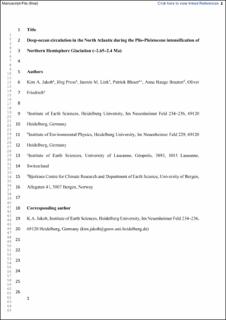| dc.contributor.author | Jacob, Kim A. | |
| dc.contributor.author | Pross, Jörg | |
| dc.contributor.author | Link, Jasmin M. | |
| dc.contributor.author | Blaser, Patrick | |
| dc.contributor.author | Braaten, Anna Hauge | |
| dc.contributor.author | Friedrich, Oliver | |
| dc.date.accessioned | 2021-11-29T12:26:22Z | |
| dc.date.available | 2021-11-29T12:26:22Z | |
| dc.date.created | 2021-11-26T12:16:50Z | |
| dc.date.issued | 2021 | |
| dc.identifier.issn | 0377-8398 | |
| dc.identifier.uri | https://hdl.handle.net/11250/2831912 | |
| dc.description.abstract | Through transporting heat around the world and thereby regulating global climate, ocean circulation is an integral part of Earth's climate system that likely changed substantially on glacial-interglacial timescales in the deep North Atlantic Ocean. However, quantitative records on deep-water dynamics in the North Atlantic older than ~1 Myr are sparse and typically of low temporal resolution. Here we provide a new record on northern- versus southern-sourced waters in the deep North Atlantic at a yet unprecedented temporal resolution. Our record is based on a novel approach (Atlantic-Pacific bottom-water temperature (BWT) difference) for an interval comprising the onset of larger-scale glaciations in the Northern Hemisphere, the Plio-Pleistocene transition (~2.65–2.4 Ma; Marine Isotope Stages G1–95). We thus have generated a new, millennial-scale-resolution BWT record based on benthic foraminiferal Mg/Ca from Ocean Drilling Program Site 849 in the East Pacific backed up with a new neodymium-isotope record on glacial-interglacial-scale resolution. The difference between our new BWT record (Site 849) and previously available BWTs from Integrated Ocean Drilling Program Site U1313 in the North Atlantic was used to decipher changes between southern- and northern-sourced waters in the deep North Atlantic. In accordance with previous studies, we document an increased influence of deep waters from high southern latitudes during glacials at the expense of northern-sourced waters. Perhaps even more importantly, our new record is highly relevant for the determination of geochemically-based sea-level records from the deep North Atlantic, which was yet limited by quantitative estimates of deep-water masses at a sufficient, (sub-)millennial-scale resolution. | en_US |
| dc.language.iso | eng | en_US |
| dc.publisher | Elsevier | en_US |
| dc.rights | Attribution-NonCommercial-NoDerivatives 4.0 Internasjonal | * |
| dc.rights.uri | http://creativecommons.org/licenses/by-nc-nd/4.0/deed.no | * |
| dc.title | Deep-ocean circulation in the North Atlantic during the Plio-Pleistocene intensification of Northern Hemisphere Glaciation (~2.65–2.4 Ma) | en_US |
| dc.type | Journal article | en_US |
| dc.type | Peer reviewed | en_US |
| dc.description.version | acceptedVersion | en_US |
| dc.rights.holder | Copyright 2021 Elsevier | en_US |
| dc.source.articlenumber | 101998 | en_US |
| cristin.ispublished | true | |
| cristin.fulltext | postprint | |
| cristin.qualitycode | 1 | |
| dc.identifier.doi | 10.1016/j.marmicro.2021.101998 | |
| dc.identifier.cristin | 1959691 | |
| dc.source.journal | Marine Micropaleontology | en_US |
| dc.identifier.citation | Marine Micropaleontology. 2021, 165, 101998. | en_US |
| dc.source.volume | 165 | en_US |

